 Dark Ages Re-Creation Company
Dark Ages Re-Creation Company

A Study in Anglo-Scandinavian Dye Colours, Pre-1200A.D.
Nina Bates, Nov 2007
Colour! It surrounds us in nature with the greens of leaves and grasses, and the purples, yellows and pinks of flowers. The skies and waters appear shades of blues, turquoise and greens while a sunset can show an array of colour from the deepest reds and purples to fuchsias and oranges. The colour of an apple, pear or raspberry make it appealing both to eat and to our eye. We can tell that earlier generations of mankind have used colour in their everyday lives from the bright colours used in illuminated manuscripts, the pottery shards with coloured glazes, the written accounts, ledgers of the past and the dyes left on the textile remains that have been found.
This is a study in dye colours, depicting colours that may have been available to people in northern Europe before the 13th century. I used plants that I either grew or harvested from the wild. I chose to limit the time period of colours because I felt that there is a rather strong definition between early and later medieval period colours. Brazilwood, Indigo and Logwood are three known natural dyes which we don't see before the 14th century. I chose the time of pre-1200 to limit the choice of dyestuffs available and make it easier to understand which colours might have more likely been available to people during a specific time period.
The Archaeological Evidence
Dyes on textile fragments found throughout Northern Europe, have been identified as Orchil lichen, Madder, Indigotin probably from Woad, Weld [1]and some unidentified colours like Yellow X and a yellow/orange colour[2]. There is evidence as well of over dyeing one colour with another. Also evidence of plants like Bog Myrtle, Ling, Weld and Dyer's Greenwood being grown or used in noticeably large quantities make it likely that yellows and browns from local plants were used.[3] Traditional dye plants from Scotland show a remarkable variety including Ling, Marsh Marigold, Foxglove, Sweet Cecily, Privet, Elder, Dock, Tansy, Purple Loosestrife, Ling Heather, Meadowsweet, Horsetail and Sorrel as well as Madder, Woad and Weld. This shows a wide range of possibilities for natural dyes. Dyer's Greenwood, Club Moss, Sweet Gale and Ling have also been found at the Viking York Archaeological site in quantities which suggest use for dyeing.[4]
While there is some evidence that large scale commercial dyeing took place in large centres like York[5], traces of madder have been found in shards of domestic-sized (c. 2 litre) pots, some of which have sooting indicating that they were heated on a fire[6]. This is indicative of smaller dye lots which could have easily been done in households or farms in less populated areas and smaller communities. Of course it could also mean that commercial dyers just used small pots.
In some areas well over 50% of the textiles sampled showed traces of dye, indicating that people wore dyed clothing on a regular basis. Madder and Indigotin are the most common dyes found. Yellows are difficult to detect due to a number of reasons. With madder red, woad blue and a variety of plants for yellow, a whole range of colours, from the three primary colours to grays, browns and blacks would have been available.[7]
The Main Dyes
Dye tests show the most common pigments to be indigotin, alarzin, purpurin and pseudopurpurin, karmenic acid and leuteolin. Indigotin is the blue pigment found in both woad and indigo. Alarzin, purpurin and pseudopurpurin are the colour elements in madder. Karmenic acid is found in Kermes and leuteolin is a yellow pigment, found in large quantities in weld, although it is found in other yellow dye producing plants as well.
Indigotin - Indigotin is the blue pigment found in both woad and indigo. It is very difficult to chemically distinguish between the two pigments. Visually Woad may be a tad more yellow than indigo and doesn't produce as deep a blue colour. Indigo pigment is about 10 times stronger than the pigment found in Woad. Woad is a very hardy plant surviving in short, colder seasons and thriving in longer, warmer ones. It will produce viable blue dye with little other than some water and compost after it is established despite the weather conditions. Woad seeds have been found throughout northern Europe while Indigo plants are tropical plants, requiring long, warm days to produce leaves and a long growing season to produce seeds. They are a modern zone 10 as opposed to woad which is a zone 3.[8]
Kermes - Kermes is a small bug which will produce a red dye. It was harvested from the evergreen oak in Spain, France, Romania, Greece and Crete[9]. In the medieval period it was also called Grainne as when dried, it looked like small grains of sand or grit. Kermes as a dye source is no longer available. We can get Cochineal, which is similar although not quite the same. Cochineal is a bug found on cactus plants from Mexico and Central America. It is 10-12 times stronger than Kermes was[10]. The Cochineal colours are reputed to be brighter and more colour fast than Kermes.
Madder - Madder is a low lying and sprawling plant, with prickly stems, tiny, unremarkable white flowers and purple fruit in the fall. The dye components are found in the roots. It takes several years for the roots to develop enough of the red pigments for dyeing. Madder will produce colours from browns, oranges, rusts, reds, purples and pinks, with every shade between as well. Madder roots require care and precise practices to obtain red colours. It is heat sensitive to temperatures over 75C and the pigment will turn brown if the dye vat is warmer than that. Acidic and alkaline dye vats can also change the colours of madder.
Weld - Also called Dyer's Rocket, this plant has the most dye pigment in it's second year of growth when it grows a tall, woody stalk with yellow flowers on the top. It is the developing seeds which produce the most pigment, although the leaves have usable pigment in the whole growth cycle of the plant. It is a strong, reliable dye plant which tolerates a wide variety of temperatures and dye vat conditions and still produces strong yellows.
Unfortunately the colour yellow doesn't always tolerate the soil conditions which have preserved the textile fragments in archeological finds. It becomes difficult to detect and can be contaminated by high iron content in soils.[11] Also, yellows are often more fugitive, fading from sunlight, washing or time. This makes it harder to determine their use on old textiles. Yellow is an easy colour to obtain, with a large number of different shades available from many different plants. There is enough evidence of yellow dye plants found in in sufficient quantities that we know many shades of yellow were used.
Mordants
A mordant is a metal salt which helps a natural dye adhere more permanently and brightly to a fibre. Common mordants would be alum, iron and copper. Alum can be obtained from mining or from a plant like club moss which absorbs the alum from the soil through it's roots. Alum was probably imported into Viking York[12].. It is mentioned in the manuscript Mappae Clavicula, dated about 821 AD so was known as a mordant during this time. Iron would be easily attained with either an iron pot or the addition of a small piece of the metal to the dye pot or mordant bath. Copper would be used the same way. Iron dulls and darkens the shades while copper usually adds a green tone.
Plant Selection
Many of these plants used for dyeing were intriguing as some were known to me as common wild flowers and garden cultivars, albeit some a tad uncommon, that can be found in Ontario. A comparison of Viking age madder with modern common madder showed that the two dyes have rather similar chemical components[13]. This gave me the idea that perhaps other plants found in that time period might also have changed little over the centuries. Further research into human paleoecology brought forth a number of studies done on plant remains in Northern Europe during the Anglo-Scandinavian time period.
I began to sift through the plant lists, first to find which plants I knew grew locally. I was able to cross-reference the plants from those found in the studies, to what I could find locally. Having both the Latin and the common name for the plants made it easy to verify the identification of local plants as being the same name as the ones in the studies. Then I had to determine some criteria to decide which plants might have been used as dye plants. Being able to grow the plant in my garden was a good starting point. A plant that was found in abundance in the wild was another. Buttercups are mentioned in two of the studies I looked at. The same variety is found commonly in the fields and ditches close to my home. I chose not to use them as as they don't grow in abundance in my area and picking a pot or grocery bag full would have denuded several areas completely. I felt that this was not an ecologically sound practice.
Raspberries, Blackberries, strawberries, sloe, cherry, plum; cereals such as wheat, spelt, barley, rye and oats; roots of wild carrot, turnips, and peas were all removed from my possible list as I found little evidence that food plants were used for dyeing. I left vetch on the list. While it was supposed to be used earlier by the Romans as an animal fodder, I found nothing to suggest this for the time period I was researching. Similarly, I left dock seeds, knotweed, lady's mantle on the list as well as several others. There is evidence that seeds from these plants were used as food in earlier centuries, [14] but after researching some Anglo-Saxon foods I felt they were no longer used in the common diet. Sorrel leaves are a food item that I left on the list. The older leaves are extremely bitter while the younger leaves are tender and much more palatable. When you trim the older leaves right back, you get a much larger fresh growth of younger leaves. It is conceivable that one would cut off and use the old, tough, bitter leaves in order to get more young leaves. Sorrel grows quite quickly, so one wouldn't be without the green for more than a few days, even if one had only one small clump of the plant. Most of the trees I eliminated just because the availability was a problem. I also removed any plants with known toxicity like nightshades. Certain plants like meadowsweet also were eliminated due to crop failure this year. As well, wild radish has such a pretty little flower, early in the season and I only had a few this year, that I chose not to use them.
My criteria ended up eliminating known food products, embracing ecologically sound gathering practices, using only reasonably low known toxicity levels and availability. The Latin name of the plants found in the studies had to match the Latin names in the plant identification book that I was using. This made is easier to reduce the number of plants to find or use to a manageable size. Some plants I had access to, but ended up not using. Others were added later in the process as research was ongoing. The beginning list included hops, nettle, knotweed, bindweed, sheep sorrel, dock, bladder campion, chickweed, wild radish, meadowsweet, lady's mantle, rowan or mountain ash, St. John's wort, yarrow, dandelion, violets, purple loosestrife, vetch, wild carrot flowers, bedstraws, nightshade, tansy, plantains, bracken ferns, common mallow, onion skins, hawthorn, ox eye daisy, marsh marigold, mullein and walnut.
I had a large supply of Lady's Mantle growing this year however it matured when I was on holidays. Celandine was also growing in abundance this year, although I found out that it dated back to pre-1200's after it had reached it's peak and had died back for the year. Sweet Cecily was also a plant known in this time period. However, this plant has a very sweet, licorice taste to the leaves and the seeds are used in cooking.[15] It's shorter growing season, sweet taste and use in cooking eliminated it as well. Walnut dye is from the green outer husk, not the hard nutshell or the nutmeat. The black walnut is native to our area. The English walnut is a similar plant, but it isn't quite as hardy in the extreme cold winters. The English Walnut was available during the time period researched.[16] I chose to substitute locally available black walnut husks for availability as the outer husks on both plants can provide an easy, colourfast and strong dark brown dye. That being said, with the drought, the trees in my locale, had few nuts this year and I had to fall back on a previously dyed sample.
The Process
I pre-mordanted sample skeins of wool yarn. Some of it was hand spun and when I realized that I wouldn't be able to finish my other spinning projects if I spent my time spinning wool for sampling. I ended up purchasing100% white, commercially spun wool yarn from a local retailer that I made in to sample sized skeins. I mordanted with alum at 12%, copper at 2% and iron at 1% ratios to the weight of the wool to be dyed. This meant I had a ready supply of sample skeins available whenever I found a viable supply of dye matter. It also kept the dye results to uniform results. I purposely used lower percentages of mordants although you can use substantially more, especially alum which can be used as high as 25%. I have found that these percentages give strong, reliable colours with less expense and less damage to yarn. Metal salts in excess can damage wool cause over dryness, brittle fibres or sticky wool . Nearly all of the colour vats are stable enough to put a skein of all three different mordanted yarns in the vat at the same time. One exception to this is madder. Madder colour is quite easily shifted by a small change in ph or the addition of a tiny bit of loose mordant. I discovered it is better to dye with madder using only one mordant at a time. The rest, I was able to put all three skeins in the dye vat at once and pull out three different colours at the end.
My minimum quantity of dye plants was ½ bag, using a generously sized plastic grocery bag as a gathering tool. The plastic bag helped keep the critters which invariably come with the plants contained, which was a nice advantage. I put the plants or flowers into a 14 litre, stainless steel pot and covered it with water. Most of the time I used plain tap water. With madder I have had the best results with using spring or distilled water. I brought the dye plants and water to a boil and then let it simmer for a minimum of 1 hour. By looking at the dye plants you can tell whether or not it needs to be simmered longer. Plants which are well cooked, withered and looking grayish, are most likely to have the dye pigments released. Some plants like tansy and yarrow are tougher and require longer cooking. The water should also be showing lots of colour. If not, then the plants need to be cooked longer or a larger volume of plants is needed.
It is best to do these experiments when the weather is warm enough to open a window if necessary. I find that a few of the plants have little odor at all. Many of them smell like slightly over cooked spinach, not a horrible smell, but noticeable. There are a few, like Tansy and Yarrow, which smell closer to the horrific side, leaving a rather medicinal, lineament rub type smell which permeates the whole house. If I were to use these two particular plants again, I'd likely do it outside on a camp stove, bbq or fire pit.
These colour samples depict a range of colours which might have been available to the people in Northern Europe before the year 1200. I did not do a lot of successive dyeing to get samples in the whole range of one colour from darkest to lightest. I feel that would be better suited to a study in one plant or along one colour range. For common colours, I chose to only do one sample each of three different mordants, so that I had three colours for each plant. Shade of various exhaust baths would be successively lighter. I chose some yellows to use with woad to make greens. The yellows I chose were from commonly known yellow dye plants such as Lady's bedstraw, Weld and Dyer's greenwood. Queen Anne's Lace or Wild Carrot slipped in as well as it was growing quite invasively in my garden this year. Take that you silly plant! Madder is such a complex dye, with numerous colours available from it that I chose to do a number of different colour studies to get it's full range of colours. Blue, well, I really like woad blue and chose to do several samples just because it is such an exciting dye process. I also only dyed white fibres. I was able to get clear colours with no alterations or deviations due to the undertones of coloured fibres.
It was an extremely fun, although messy and time consuming project. I was absolutely thrilled by the colours I obtained in every dye pot. It is a wonderful sight to pull out of a pot a hank of wool or length of roving or wool locks which is coloured brightly or substantially differently than when it went in. I had only one disappointment - vetch produced an unexciting set of pale beiges. There were some very unexpected results such as with dock and sorrel seeds, both producing bright coppers and interesting browns, and with the soft greens of the bracken ferns. It was a project I will continue with over time to recreate and expand upon my colour palette.
Noted information of variable usefulness
|
Plant used |
Special notes on plant/dye vat |
Colour notes |
|
Tansy Yarrow |
Must be related/ stinks up whole house like bad horse lineament |
Uninspiring yellows |
|
Vetch |
Not worth effort |
Pale beiges |
|
Queen Anne's Lace/Wild Carrot |
Lots available in wild, slightly strong smell |
Dull yellow which is okay but the brown with iron is superlative |
|
Weld |
I love this yellow, good for overdyeing with woad |
YELLOW! |
|
Dyer's Greenwood |
Difficult to germinate, worth the effort to grow for the dye |
Yellow |
|
Madder |
Loki must be the dye god of Madder |
Everything from brown, orange, red and purple |
|
Dock Seeds |
Use before they turn brown |
Wonderful unexpected colours |
|
Sorrel Seeds |
Use before they turn brown |
Wonderful unexpected colours |
|
Sorrel Roots |
Took a long boil, try alcohol extraction next for woody roots |
Reddish and lovely browns |
|
Mallow |
Makes slimy, off smelly dye vat |
Not worth the dye vat ickyness |
|
Bracken Fern |
Took long time to boil down |
Lovely, soft greens |
|
Ox Eye Daisy |
Normal dye process |
Yellow, iron brown lovely |
|
Woad 1st year leaves |
Heavy feeder, lots of water |
Blue, blue, blue |
|
Woad 2nd year leaves |
Pinky browns |
|
|
Woad 1st year leaves after blue pigment extracted |
Brown |
|
|
Lady's Bedstraw |
Flowering tops only |
Unexceptional yellows |
|
Dandelion |
Flowers only |
Pretty, soft yellows |
More images will follow as time allows
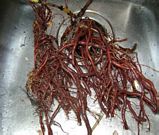 |
 |
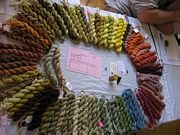 |
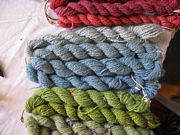 |
| Dye vat | Fresh madder root | Colours | Colours |
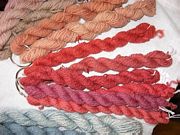 |
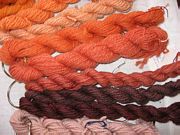 |
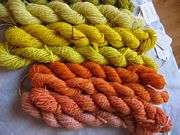 |
|
| Colours | Colours | Colours |
Banham, Debby, Food and Drink in Anglo-Saxon England, Tempus Publishing Ltd, Gloucestershire, 2004
Barret, James, Allan Hall, Cluny Johnstone, Harry Kenward, Terry O'connor, Steve Ashby, Plant and animal remains from Viking Age deposits at Kaupang, Norway, Department of Archaeology, University of York, York, 2004
Bender Jorgensen, Lise, Textile Industries of the Early Medieval World to 1000 AD, The Cambridge History of Western Textiles, Jenkins, D.T., editor, Cambridge University Press, Cambridge 2003
Bender Jorgensen, Lise and Walton, Penelope, Dyes and Fleece Types in Prehistoric Textiles from Scandinavia and Germany, Journal of Danish Archaeology Vol 5, 1986
Buchanan, Rita, A Dyer's Garden: From Plant to Pot Growing Dyes for Natural Fibers, Interweave Press, Loveland, Colorado, 1995
Dean, Jenny and Karen Diadick-Casselman, Wild Colour, Watson-Guptill Publications, New York, 1999
Glob, P.Vl, The Bog People, Granada Publishing Limited, by Paladin, London. 1971
Goodwin, Jill, A Dyer's Manual, Pelham Books, London, 1982
Grierson, Sue, Vegetable Dyes of Scotland, Journal of the Society of Dyers and Colourists, Vol 100, 1984
Hagen, Ann, A Handbook of Anglo-Saxon Food Processing and Consumption, Anglo-Saxon Books, Norfolk, 2002
Hall, A.R.; P.R. Tomlinson, R.A. Hall, G.W. Taylor, and P. Walton. 1984. "Dyeplants from Viking York." Antiquity LVIII, no. 222 (March 1984)
Hall, Allan and Kenward, Harry , Technical Report: plant and invertebrate remains from Iron Age deposits at Sutton Common, South Yorkshire (site code SCOM02-03). Part I. Text and Publication Tables, Department of Archaeology, University of York, York, 2005
Ingstad, A.S., "The Functional Textiles from the Oseberg Ship", Textilsymposium (Neumünster, 1982)
Lee, Raymond, L. "American Cochineal in European Commerece, 1526-1625", The Journal of Modern History, Vol. 23, No 3. Sept 1951
Liles, J,N. The Art and Craft of Dyeing:Traditional Recipes for Modern Use, University of Tennessee Press, Knoxville, 1990
McGuffin, Nancy, Spectrum, Dye Plants of Ontario, Burr House Spinners and Weaver's Guild, Richmond Hill, 1986
Owen-Crocker, Gale, R., Dress in Anglo-Saxon England, Boydell Press, Woodbridge, 2004
Pellew, Charles, E., Mediaeval Dyestuffs, The Bulletin of the Bobbin and Needle Club, Vol. 2, 1918
Peterson, Roger Tory, and Margaret McKenny, Peterson Field Guides Wildflowers, Northeastern/Northcentral North America, Houghten Mifflen co., New York, 1968
Plowright, Charles, B., "British Dye Plants", Journal of the Royal Horticultural Society, Vol. 26, Pt. 2, 1901
Pritchard, Frances, A., Late Saxon Textiles from the City of London, Ingstad, Anne Stine, Medieval Archaeology, Vol. 28, 1984
Richter's Herbs Seed Catalogue, 2007
Taylor, G.W., "Detection and Identification of Dyes on Anglo-Scandinavian Textiles", Studies in Conservation, Vol.28, No. 4, November 1983
Van Stralen, Trudy, Indigo, Madder and Marigold, Interweave Press , Loveland, Colorado, 1994
Walton, Penelope, Textiles, Cordage and Raw Fibre from 16-22 Coppergate, Council for British Archaeology, York Archaeological Trust, York 1989
Walton Rogers, Penelope, "The Anglo-Saxons and Vikings in Britain, AD 450-1050", in The Cambridge History of Western Textiles, Jenkins, D.T., editor, Cambridge University Press, Cambridge 2003
Walton Rogers, Penelope, Cloth and Clothing in Early Anglo-Saxon England, Council for British Archaeology, York, 2007
[1] Taylor, 1983
[2] Bender Jorgensen and Walton, 1986, pg 186
[3] Walton Rogers, 2003, pg.126
[4] Hall, et al, 1984, pg 59
[5] Owen-Crocker, 2004, pg. 306
[6] Ibid, pg 305
[7] Taylor, 1983, pg. 158
[8] Richter's Seed Catalogue, 2007
[9] Lee, 1951, pg 205
[10] Lee, 1951, pg 206
[11] Taylor, 1983, pg 153
[12] Taylor, 1983, pg 153
[13] Taylor, 1983, pg 159
[14] Glob, 1971
[15] Hagen, 2002, pg 20
[16] Banham, 2004, pg 51